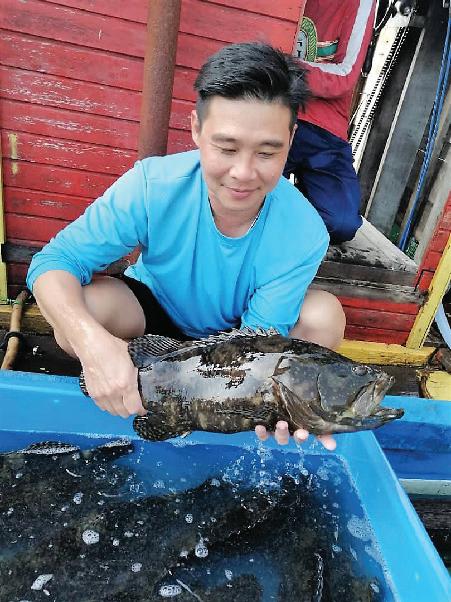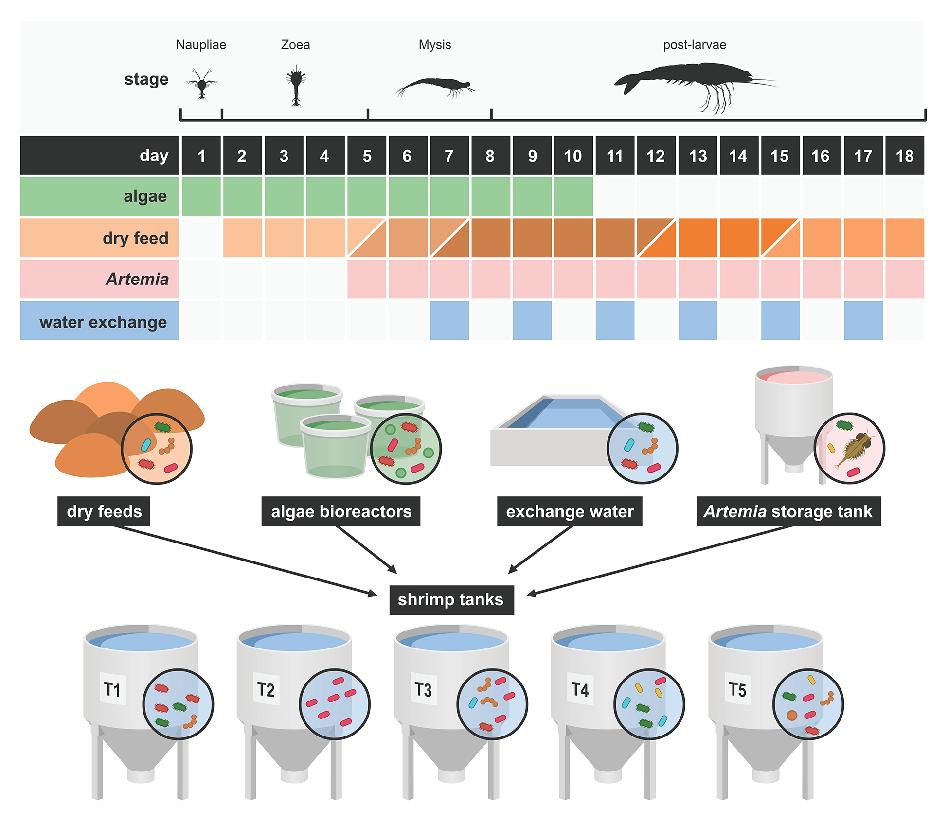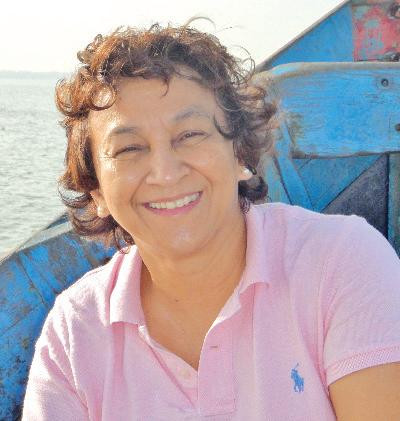
6 minute read
Hybrid grouper farming: Manoeuvring colossal lows in demand in 2020
A year-long impact of the Covid-19 pandemic on the demand for live fish required strategic changes at a farm.
Operation Manager, Mohd Addin Aazif Hj Mokhtar oversees operations at Grouper Palace, a group cage farm located off Langkawi Island, in the state of Kedah in northern Peninsular Malaysia. Grouper Palace is part of JK Investments, a Kuwait-based agriculture company. Langkawi is a major destination for local and foreign tourists and it is an ideal market for fresh seafood. Set up in 2018 through the acquisition of several cage farms off Langkawi, the farm began its first harvest in 2019.
The farm focusses solely on the hybrid grouper (tiger grouper, Epinephelus fuscoguttatus x giant grouper, E. lanceolatus (TGxGG) which Addin, as an MSc student at the Borneo Marine Research Institute, Universiti Malaysia Sabah (UMS), is familiar with. He was part of the team working on the aquaculture development of this grouper with Dr Shigeharu Senoo. Asian table size (1-1.5kg) hybrid and several groupers are usually marketed live or as fresh fish.
The company has a good business plan for 2018-2023. All was going according to plan, with the first sales at the end of 2019. Grouper Palace focusses on innovative and eco-friendly marine fish farming. “In 2019, we stocked 100,000 fingerlings in the cages. We were happy as survival was good at 70-80%,” said Addin. “Juveniles of 7 inches (17.5cm) weighing 150g grow to 1-1.5kg in less than 12 months. We had tonnes of fish to sell as live fish to Hong Kong using well-boats, to local seafood restaurants and the domestic market as well as for export. Everything was according to plan,” said Addin during a webinar organised by the Malaysian Fisheries Society, held in October 2020 to discuss the impact of Covid-19 on the aquaculture sector in Malaysia.
“We had good targets for 2020 and I was expecting to harvest more fish in early 2020 too. Of course, we did not expect this Covid-19 pandemic. Now even though the farm has fish in the cages, we are not able to sell the fish.”
Mohd Addin Aazif injecting fish with hormones for the first sex change prior to breeding. Some 300g hybrid groupers, two months after stocking at 100g/fish
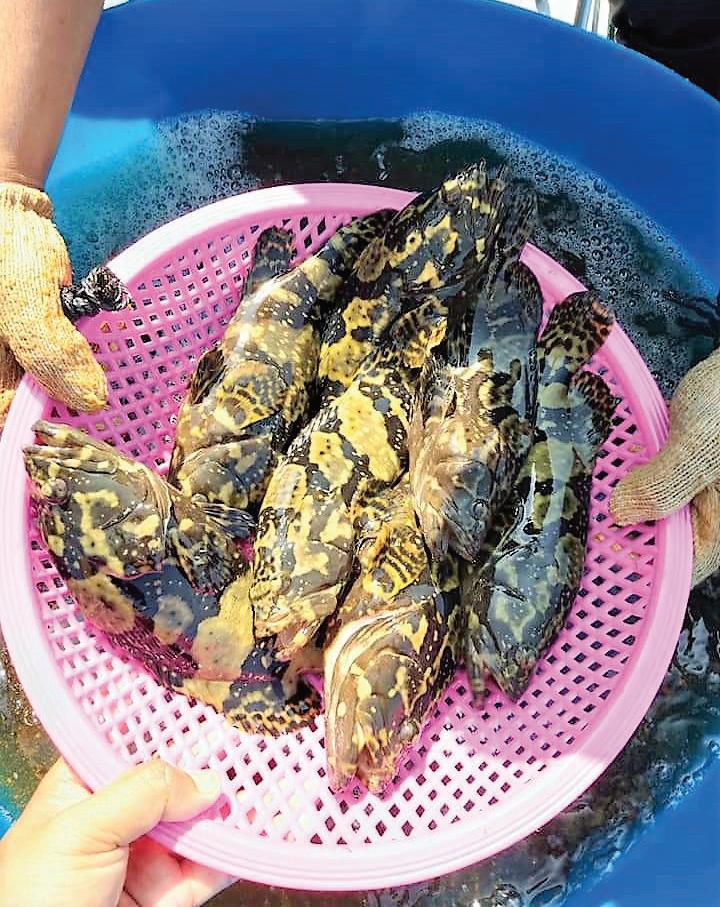
Marketing live hybrid groupers
The company had already lined up plans for marketing its stock. It had planned to sell in domestic and international markets− the latter being a key market for live groupers. The target export markets were China, Hong Kong, Singapore and other Southeast Asian countries. Marketing included promotions in aquaculture and seafood trade shows. The target buyers were agents, distributors, restaurants and fish markets but the company also planned direct sales. “The Hong Kong well-boats would collect the live groupers and would henceforth distribute them regionally. But way before 2020, there were no well-boats plying the area. For us in Langkawi, we depend fully on these boats; if we were to do our own transportation to other parts of Malaysia by land, it will be costly. Furthermore, these boats take large volumes of fish.”
Malaysia imposed several lockdowns throughout 2020. Stricter lockdowns included the closure of all restaurants and hotels throughout the country. The major markets for live groupers are seafood restaurants where the demand is particularly high during the end of year wedding season, which is followed by the Chinese New Year in February 2021. Flights were cancelled and sending air cargo to Hong Kong and China, as well as to Singapore was not possible.
Lower prices
Prices were depressed in international and domestic markets in 2020. Based on data from the fish marketing organisation in Hong Kong, the declining price over the period from May to October 2020 affected the following fish: brown marble, brown spotted, camouflage and green groupers. Prices/kg dropped in October 2020 to the following: brown marble grouper, (HKD237.57; USD30.64) brown spotted grouper (HKD213.00; USD27.5), camouflage grouper (HKD290.33; USD37.4) and green grouper (HKD144.33; USD18.6).
“In 2019, we could sell our fish at MYR33-35/kg (USD8.3-8.8/kg) but in October 2020, the prices were only MYR18/kg (USD4.5/kg). We have stories of farmers throwing away their fish. At the same time, fish were coming in from Indonesia, undercutting with lower offer prices. We only saw the large price drops with the groupers as these are 'luxury fish'. Prices for other marine fish such as pompano and snappers remain relatively stable.” Addin attributed lower prices to changing buying patterns- with incomes affected, consumers opted for cheaper fish.
Changing strategy
Over at Grouper Palace, Addin adopted a strategy of maintaining the groupers in the cages until they reach 5-7kg and target a different market, rather than compete with the smaller farmers. “As a big company, these low prices are at the edge of our production costs. In the meantime, we also changed our species to snappers but it will be 1-1.5 years before we can harvest them.
“At the farm, it has been our strategy to only use extruded feeds. With full feeding, our feed consumption is around 20-30 tonnes/month and this is very costly at MYR5/kg. To cut costs, we feed for 2 days, with one day off. Fish will still grow but it will be slower to reach our target of 5-7kg per fish.”
Over the past year, the situation for marine fish farms, not only for Grouper Palace, has been dire. In October, there was a slight reprieve when the government allowed for interstate travel and Langkawi attracted domestic tourists. With hotels and restaurants open, but not at full capacity, Addin said, “We saw prices creeping up, demand was up but towards the end of 2020, it slowed again.”
Lessons learnt
“What we have learnt from this pandemic is that original plans may get derailed. We always need to innovate according to situations and market demand. At Grouper Palace, we learnt to change our stocking plans, species in line with demand and feeding regime. This applies not only in this pandemic year but also for any adverse situation in the future,” said Addin.
Fortunately, the farm produces its fry and fingerlings from its own broodstock. It did not face any fry shortage. In 2020, more than 70% of the hybrid grouper fry supply from Indonesia was disrupted when the Indonesian authorities closed its biosecurity facility for exports. “It was farming as usual for snappers, pompano and seabass farms as fry supply is from local hatcheries. In the future, we should be thinking of self-sufficiency in hybrid grouper fry supply, as its farming is increasing,” said Addin.
“My advice is that we should always have a plan B for the farm, perhaps a diverse set of species to farm. We could plan better to meet market needs, like the higher demand at the end of the year to match with wedding seasons in Malaysia. Situations change and so should plans.”
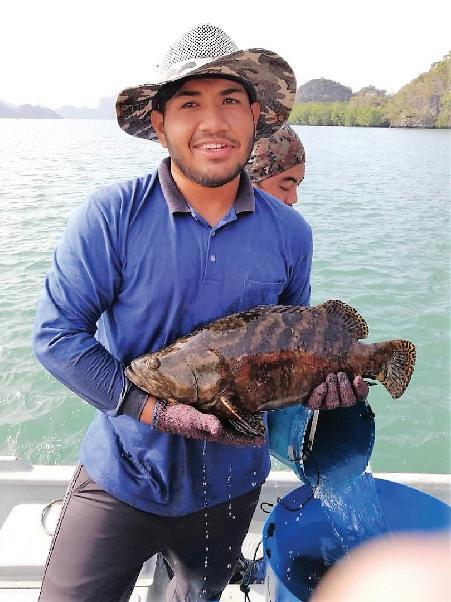

At Grouper Palace, from left, Abdul Karim, farm team leader holding a 3kg hybrid grouper; a harvest of 3-4kg hybrid groupers and Marvin Loh, Manager of Langbiru Fisheries, selecting fish for the Singapore market.
